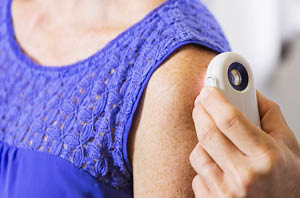Skin Cancer Screening
Our skin care experts diagnose and treat a wide range of conditions such as skin cancer, acne, rosacea, psoriasis, eczema, warts, rashes, moles, and more. We offer full body skin exams for skin cancer screenings and diagnose and treat most skin conditions. We’re dedicated to effectively treating your skin conditions and helping you look and feel your best.
Skin exams are not scary. Skin cancer prevention is one of the easiest and most proactive ways to have healthy skin. Here’s a step-by-step guide on what to expect during a skin exam, and relieve any anxieties you may have.
How to Prepare for a Skin Exam
In anticipation of your appointment, make note of any spots on your skin that you’re concerned about, and be sure to bring them up during the appointment. You are the best detector of changes in your skin.
Before you go in for your skin exam, make sure you are not wearing:
– Makeup
– Jewelry
– Tinted moisturizer
– Nail polish
– Bandages or braces
Providers need to see all of your skin in its natural state, and the items above can cover up skin conditions.
What Areas of my Body Are Checked During an Exam?
You will be asked to change into a gown and checked from your scalp to the bottom of your feet, including between your toes and fingers, and in your mouth. The provider will examine your body in its entirety and look for suspicious spots on the skin that could potentially be cancerous.
What Kinds of Medical Tools Are Used During the Exam?
A handheld dermatoscope (brightly lit magnification tool) may be used to inspect skin lesions in more detail. Your provider may call out audibly the moles or lesions they see for them to be recorded in your records. This information is then used as a baseline for future checkups to determine if there are any skin changes.
How Long Does the Exam Take?
A skin exam tends to take 10-15 minutes. The amount of time may vary, depending on what is found during the exam.
How Often Should You Check Your Body for Skin Cancer?
Self-exams should be done every three to six months. Ensure that you and your family members are checking your skin frequently with a full-length mirror and a handheld mirror in order to examine your skin front and back, top to bottom. Make note of any new skin developments as well as any changes to existing moles and lesions.
When noting changes in pigmented spots or moles, follow the ABCDEs of Melanoma (a type of skin cancer,) from the American Academy of Dermatology Association:
- A is for Asymmetry; one half of the spot is unlike the other half.

- B is for Border; the spot has an irregular, scalloped, or poorly defined border.

- C is for Color; the spot has varying colors from one area to the next, such as shades of tan, brown or black, or areas of white, red, or blue.

- D is for Diameter; while melanomas are usually greater than 6 millimeters, or about the size of a pencil eraser, when diagnosed, they can be smaller.

- E is for Evolving; the spot looks different from the rest or is changing in size, shape, or color.

How Often Should You Get a Full Body Skin Exam?
The American Cancer Society recommends people between the ages of 20 and 40 get a professional skin exam every three years – especially if you live in sunny climates. This recommendation jumps to once annually for people over age 40.
You should get a full body skin exam once a year if you have one or more of the following risk factors:
- Fair skin (typically people with blonde or red hair)
- You or someone in your family has a history of;
- Skin cancer
- Cumulative sun exposure
- Burn or freckle after sun exposure
- Weakened immune system
- Precancerous conditions including Ak’s
- Using tanning beds
- If a growth, mole, or skin tag has changed
- If you have more than 50 moles
- If you have a new growth or a spot that simply looks weird
- Have had significant sun exposure through the years or high tanning bed use
What Happens if Something Suspicious Is Found?
If your provider discovers something suspicious and potentially cancerous on your skin, they may:
- Take a photo for your medical records, measure the skin lesion, and monitor it
- Perform a skin biopsy.
- Your provider will clean the skin and inject anesthesia into the lesion area to numb it (you will feel a slight pinch)
- A blade or scalpel will be used to take a sample of the skin (don’t worry- you shouldn’t feel any pain with this part)
- The sample will be sent to pathology and your provider will contact you with the results
- If the results are cancerous, the lesion will need to be removed or treated with other methods
Skin Cancer Prevention With Sun Safety
Practice safe sun habits. Sunlight has harmful UV rays which can cause skin cancer. We don’t need to avoid the sun, but we can do these things to minimize the harmful impacts on our skin:
- Apply a minimum of 40 SPF sunscreen 30 minutes before going out into the sun
- Seek shade as often as possible at high peak hours
- Wide brim hat. (Covers ears and helps shade neck)
- Wear protective clothing
- Wear sunglasses with UV blocking lenses
- Don’t use tanning beds

What You Can Do
The words “skin cancer” are scary, but a skin exam is not. Certainly, it is much better to be proactive and preventative with your skin health than to be an avoidant. A skin exam provides a baseline for you and your provider to measure against any future changes to your skin. Take control of your skin health. Do self exams, practice safe sun habits, and contact Stellis Health – Medical Skin Care today to make an appointment for a baseline skin exam.

